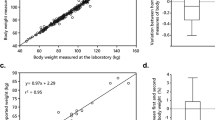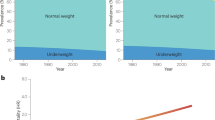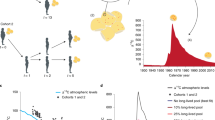Abstract
As individuals gain weight, they increase the amount of fat that they accrue on their body. This causes adipocytes to enlarge and increases not only subcutaneous fat but also deposits fat in other vulnerable areas of the body. This ectopic fat is deposited in the intra-abdominal visceral fat depot, in muscle, in the liver and in the beta cells. Fat in these locations initiates a dysfunctional state in these insulin-sensitive tissues leading to insulin resistance, the appearance of the Metabolic Syndrome, and an increased risk of developing both type 2 diabetes and cardiovascular disease. A loss of weight and with it a loss of fat decreases this risk.
This is a preview of subscription content, access via your institution
Access options
Subscribe to this journal
Receive 12 print issues and online access
$259.00 per year
only $21.58 per issue
Buy this article
- Purchase on Springer Link
- Instant access to full article PDF
Prices may be subject to local taxes which are calculated during checkout
Similar content being viewed by others
References
Cefalu WT, Bray GA, Home PD, Garvey WT, Klein S, Pi-Sunyer FX, et al. Advances in the science, treatment, and prevention of the disease of obesity: reflections from a Diabetes Care Editors’ Expert Forum. Diabetes Care. 2015;38:1567–82.
Alberti KGMM, Eckel RH, Grundy SM, Zimmet PZ, Cleeman JI, Donato KA, et al. Harmonizing the metabolic syndrome: a joint interim statement of the International Diabetes Federation Task Force on Epidemiology and Prevention; National Heart, Lung, and Blood Institute; American Heart Association; World Heart Federation; International Atherosclerosis Society; and International Association for the Study of Obesity. Circulation. 2009;120:1640–45.
Wilson PW, Meigs JB. Cardiometabolic risk: a Framingham perspective. Int J Obes. 2008;32:S17–20.
Ballantyne CM, Hoogeveen RC, McNeil AM, Heiss G, Schmidt MI, Duncan BB, et al. Metabolic syndrome risk for cardiovascular disease and diabetes in the ARIC study. Int J Obes. 2008;32:S21–4.
Pi-Sunyer FX. The medical risks of obesity. Postgrad Med. 2009;121:21–33.
Kuk JL, Katzmarzyk PT, Nichaman MZ, Church TS, Blair SN, Ross R. Visceral fat is an independent predictor of all-cause mortality in men. Obesity. 2006;14:336–41.
Poirer P, Després JP. Waist circumference, visceral obesity, and cardiovascular risk. J Cardiopul Rehabilit. 2003;23:161–69.
Hayashi T, Boyko EJ, McNeely M, Leonetti DL, Kahn SE, Fujimoto WY. Minimum waist and visceral fat values for identifying Japanese Americans at risk for the metabolic syndrome. Diabetes Care. 2007;30:120–7.
Nakamura T, Tokunaga K, Shimomura L, Nishida M, Yoshida S, Kotani K, et al. Contribution of visceral fat accumulation to the development of coronary artery disease in non-obese men. Atherosclerosis. 1994;107:239–46.
Boyko EJ, Fujimoto WY, Leonetti DL, Newell-Morris L. Visceral adiposity and risk of type 2 diabetes: a prospective study among Japanese Americans. Diabetes Care. 2000;23:465–71.
Vega GL, Adams-Huet B, Peshock R, Willett D, Shah B, Grundy SM. Influence of body fat content and distribution on variation in metabolic risk. J Clin Endocrinol Metab. 2006;91:4459–66.
Pascot A, Lemieux S, Lemieux I, Prud’homme D, Tremblay A, Bouchard C, et al. Age-related increase in visceral adipose tissue and body fat and the metabolic risk profile of premenopausal women. Diabetes Care. 1999;221:1471–8.
Patel S, Unwin N, Bhopal R, et al. A comparison of proxy measures of abdominal obesity in Chinese, European and South Indian adults. Diab Med. 1999;16:853–60.
Després JP, Moorjani S, Lupien PJ, et al. Regional distribution of body fat, plasma lipoproteins, and cardiovascular disease. Arteriosclerosis. 1990;10:497–511.
Després JB, Lemieux I. Abdominal obesity and metabolic syndrome. Nature. 2006;444:881–7.
Kaul S, Rothney MP, Peters DM, Wacker WK, Davis CE, Shapiro MD, et al. Dual-energy x-ray absorptiometry for quantification of body fat. Obesity. 2012;20:1313–18.
Weisberg SP, McCann D, Desai M, Rosenbaum M, Leibel RL, Ferrante AW. Obesity is associated with macrophage accumulation in adipose tissue. J Clin Invest. 2003;112:1796–808.
McLaughlin T, Ackerman SE, Shen L, Engleman E. Role of innate and adaptive immunity in obesity-associated metabolic disease. J Clin Invest. 2017;127:5–13.
Chawla A, Nguyen KD, Goh YP. Macrophage-mediated inflammation in metabolic disease. Nat Rev Immunol. 2011;11:738–49.
Bild DE, Bluemke DA, Burke GL, et al. Multi-ethnic study of atherosclerosis: objectives and design. Am J Epidemiol. 2010;171:980–8.
Grundy SM, Brewer HB Jr, Cleeman JL, Smith SC Jr, Lenfant C, American Heart Association; National Heart, Lung, and Blood Institute. Definition of Metabolic Syndrome: report of the National Heart, Lung, and Blood Institute/American Heart Association conference on scientsific issues related to definition. Circulation. 2004;109:433–38.
Tschkonia T, Thomou T, Zhu Y, Karagiannides I, Pothoulakis C, Jensen MD, et al. Mechanisms and metabolic implications of regional differences among fat depots. Cell Metab. 2013;17:644–56.
Lumeng CN, Bodzin JL, Saltiel AR. Obesity induces a phenotypic switch in adipose tissue macrophage polarization. J Clin Invest. 2007;117:175–84.
Ahima RS, Flier JS. Adipose tissue as an endocrine organ. Trends Endocrinol Metab. 2000;11:327–32.
Britton KA, Massaro JM, Murabito JM, Kreger BE, Hoffman U, Fox CA. Body fat distribution, incident cardiovascular disease, cancer, and all-cause mortality. J Am Coll Cardiol. 2013;62:921–5.
Ding J, Hsu FC, Harris TB, Liu Y, Kritchevsky SB, Szkio M, et al. The association of pericardial fat with incident coronary heart disease: the Multi-Ethnic Study of Atherosclerosis (MESA). Am J Clin Nutr. 2009;90:499–504.
Mahabadi AA, Massoro JM, Rosito GA, Levy D, Murabito JM, Wold PA, et al. Association of pericardial fat, intrathoracic fat, and visceral abdominal fat with cardiovascular disease burden: the Framingham Heart Study. Eur Heart J. 2009;30:850–6.
Rosito GA, Massaro JM, Hoffman U, Ruberg FL, Mahabadi AA, Vasan RS, et al. Pericardial fat, visceral abdominal fat, cardiovascular disease risk factors, and vascular calcification in a community-based sample: the Framingham Heart Study. Circulation. 2008;117:605–13.
Weyer C, Funahashi T, Tanaka S, Hotta K, Matsuzawa Y, Pratley RE, et al. Hypoadiponectinemia in obesity and type 2 diabetes: close association with insulin resistance and hyperinsulinemia. J Clin Endocrinol Metab. 2001;86:1930–35.
Cnop M, Havel PJ, Utzschneider K, Carr DB, Sinha MK, Boyko EJ, et al. Relationship of adiponectin to body fat distribution, insulin sensitivity and plasma lipoproteins: evidence for independent roles of age and sex. Diabetologia. 2003;46:459–69.
Takemura Y, Walsh K, Ouchi H. Adiponectin and cardiovascular inflammatory responses. Curr Atheroscler Rep. 2007;9:238–43.
Selcuk MT, Selcuk H, Temizhan A, Maden O, Saydam GS, Dogan M, et al. Impact of plasma adiponectin levels to the presence and severity of coronary artery disease in patients with metabolic syndrome. Coron Artery Dis. 2008;19:79–84.
Zhu W, Cheng KK, Vanhoutte PM, Lam KS, Xu A. Vascular effects of adiponectin, molecular mechanisms and potential therapeutic intervention. Clin Sci. 2008;114:36–74.
Pinnick KE, Nicholson G, Manolopoulos KN, McQuaid SE, Valet P, Frayn KN, et al. Distinct developmental profile of lower-body adipose tissue defines resistance against obesity-associated metabolic complications. Diabetes. 2014;63:3785–97.
Nicklas BJ, Penninx BW, Cesari M, Kritchevsky SB, Newman AB, Kanaya AM, et al. Association of visceral adipose tissue with incident myocardial infarction in older men and women: the Health, Aging and Body Composition Study. Am J Epidemiol. 2004;160:741–9.
Ibrahim MM. Subcutaneous and visceral adipose tissue: structural and functional differences. Obes Rev. 2010;11:11–18.
Hocking S, Samocha-Bonet D, Milner KL, Greefield KR, Chisholm DJ. Adiposity and insulin resistance in humans: the role of the different tissue and cellular lipid depots. Endocr Rev. 2013;34:463–500.
Krssak M, Falk Petersen K, Dresner A, DiPietro L, Vogel SM, et al. Intramyocellular lipid concentrations are correlated with insulin sensitivity in humans: a 1H NMR spectroscopy study. Diabetologia. 1999;42:113–6.
Perseghin G, Scifio P, De Cobelli F, Pagliato E, Battezzati A, Arceloni C, et al. Intramyocellular triglyceride content is a determinant of in vivo insulin resistance in humans: 1H-13C nuclear magnetic resonance spectroscopy assessment in offspring of type 2 diabetic parents. Diabetes. 1999;48:1600–6.
Dresner A, Laurent D, Marcucci M, Griffin ME, Dufour S, Cline GW, et al. Effects of free fatty acids on glucose transport and IRS-1-associated phosphatidylinositol 3-kinase activity. J Clin Invest. 1999;103:253–9.
Griffin ME, Marcucci MJ, Cline GW, et al. Free fatty acid-induced insulin resistance is associated with activation of protein kinase C theta and alterations in the insulin signaling cascade. Diabetes. 1999;48:1270–4.
Choi CS, Savage DB, Abu-Elheiga L, Liu ZX, Kim S, Kulkarni A, et al. Continuous fat oxidation in Acetyl-CoA carboxylase 2 knockout mice increases total energy expenditure, reduces fat mass, and improves insulin sensitivity. Proc Natl Acad Sci USA. 2007;1104:16480–5.
Matsuzaka T, Shimano H, Yahagi N, Kato T, Atsumi A, Yamamoto T, et al. Crucial role of long-chain fatty acid elongase, Elov16, in obesity-induced insulin resistance. Nat Med. 2007;13:1193–202.
Savage DB, Choi CS, Samuel VT, Liu ZX, Zhang D, Cline GW, et al. Reversal of diet-induced hepatic steatosis and hepatic insulin resistance by anti-sense oligonucleotide inhibitors of Acetyl-CoA carboxylases 1 and 2. J Clin Invest. 2006;116:817–24.
Varela GM, Antwis DA, Dhir R, Yin X, Singhai NS, Graham MJ, et al. Inhibition of ADRP prevents diet-induced insulin resistance. Am J Physiol Gastrointest Liver Physiol. 2008;295:G621–8.
Zhang D, Liu Z-X, Choi CS, Tian L, Kibbey R, Dong J, et al. Mitochondrial dysfunction due to long-chain Acyl-CoA dehydrogenase deficiency causes hepatic steatosis and hepatic insulin resistance. Proc Natl Acad Sci USA. 2007;104:17075–80.
Kim JK, Gavrilova O, Chen Y, Yu C, Moore IK, Pypaert M, et al. Tissue-specific overexpression of lipoprotein lipase causes tissue-specific insulin resistance. Proc Natl Acad Sci USA. 2001;98:7522–7.
Anstee QM, Day CP. Progression of NAFLD to diabetes mellitus, cardiovascular disease or cirrhosis. Nat Rev Gastroenterol Hepatol. 2013;10:330–44.
McPherson S, Hardy T, Henderson E, Burt AD, Day CP, Anstee QM. Evidence of NAFLD progression from steatosis to fibrosing-steatohepatitis using paired biopsies: Implications for prognosis and clinical management. J Hepatol. 2015;62:1148–55.
Pais R, Charlotte F, Fedchuk L, Bedossa P, Lebray P, Poynard T, LIDO Study Group. et al. A systematic review of follow-up biopsies reveals disease progression in patients with non-alcoholic fatty liver. J Hepatol. 2013;59:550–6.
Wong VW-S, Wong GL-H, Choi PC-L, Chan AW-H, Li MK-P, Chan H-Y, et al. Disease progression of non-alcoholic fatty liver disease: a prospective study with paired liver biopsies at 3 years. Gut. 2010;59:969–74.
Yki-Järvinen H. Non-alcoholic fatty liver disease as a cause and a consequence of metabolic syndrome. Lancet Diabetes Endocrinol. 2014;2:901–10.
Seppälä-Lindroos A, Vehkavaara S, Häkkinen A-M, Goto T, Westerbacka J, Sovijärvi A, et al. Fat accumulation in the liver is associated with defects in insulin suppression of glucose production and serum free fatty acids independent of obesity in normal men. J Clin Endocrinol Metab. 2002;87:3023–8.
Lambert JE, Ramos-Roman MA, Browning JD, Parks EJ. Increased de novo lipogenesis is a distinct characteristic of individuals with nonalcoholic fatty liver disease. Gastroenterol. 2014;146:726–35.
Fabbrini E, Mohammed BS, Magkos F, Korenblat KM, Patterson BW, Klein S. Alterations in adipose tissue and hepatic lipid kinetics in obese men and women with nonalcoholic fatty liver disease. Gastroenterol. 2008;134:424–31.
Korenblat KM, Fabbrini E, Mohammed BS, Klein S. Liver, muscle, and adipose tissue insulin action is directly related to intrahepatic triglyceride content in obese subjects. Gastroenterol. 2008;134:1369–75.
Donnelly KL, Smith CI, Schwarzenberg SJ, Jessurun J, Boldt MD, Parks EJ. Sources of fatty acids stored in liver and secreted via lipoproteins in patients with nonalcoholic fatty liver disease. J Clin Invest. 2005;115:1343–51.
Boden G. Fatty-acid induced inflammation and insulin resistance in skeletal muscle and liver. Curr Diab Rep. 2006;6:177–81.
Boden G, Chen X, Ruiz J, White JV, Rossetti L. Mechanisms of fatty acid-induced inhibition of glucose uptake. J Clin Invest. 1994;93:2438–45.
Pitt HA. Hepatic-pancreato-biliary fat: the good, the bad and the ugly. HPB. 2007;9:92–7.
Engl J, Sturm W, Sandhofer A, Kaser S, Tschoner A, Tatarczyc T, et al. Effect of pronounced weight loss on visceral fat, liver steatosis, and adiponectin isoforms. Eur J Clin Invest. 2008;38:238–44.
Fontbonne AM, Eschwege EM. Insulin and cardiovascular disease. Paris Prospective Study. Diabetes Care. 1991;14:461–9.
Després JP, Lamarche B, Mauriége P, Cantin B, Dagenais GR, Moorjani S, et al. Hyperinsulinemia as an independent risk factor for ischemic heart disease. N Engl J Med. 1996;334:952–7.
Pouliot MC, Després JP, Nadeau A, Moorjani S, Prud’homme D, Lupien PJ, et al. Visceral obesity in men. Associations with glucose tolerance, plasma insulin, and lipoprotein levels. Diabetes. 1992;41:826–34.
Donath MY, Dalmas E, Sauter NS, Bӧni-Schnetzler M. Inflammation in obesity and diabetes: islet dysfunction and therapeutic opportunity. Cell Metab. 2013;17:860–72.
Petersen KF, Oral EA, Dufour S, et al. Leptin reverses insulin resistance and hepatic steatosis in patients with severe lipodystrophy. J Clin Invest. 2002;109:1345–50.
Petersen KF, Dufour S, Befroy D, Lehrke M, Hendler RE, Shulman GI. Reversal of nonalcoholic hepatic steatosis, hepatic insulin resistance, and hyperglycemia by moderate weight reduction in patients with type 2 diabetes. Diabetes. 2005;54:603–8.
Lim EL, Hollingsworth KG, Aribisala BS, Chen MJ, Mathers JC, Taylor R. Reversal of type 2 diabetes: normalization of beta cell function in association with decreased pancreas and liver triacylglycerol. Diabetologia. 2011;54:2506–14.
Acknowledgements
This presentation was given at the 11th International Symposium on In Vivo Body Composition Studies held on June 25-27th, 2018 at Columbia University Medical Center in New York.
Author information
Authors and Affiliations
Corresponding author
Ethics declarations
Conflict of interest
The author declares that he has no conflict of interest.
Rights and permissions
About this article
Cite this article
Pi-Sunyer, X. Changes in body composition and metabolic disease risk. Eur J Clin Nutr 73, 231–235 (2019). https://doi.org/10.1038/s41430-018-0320-x
Received:
Accepted:
Published:
Issue Date:
DOI: https://doi.org/10.1038/s41430-018-0320-x
This article is cited by
-
CT-measured body composition radiomics predict lymph node metastasis in localized pancreatic ductal adenocarcinoma
Discover Oncology (2023)
-
Fat-to-muscle ratio as a predictor for dyslipidaemia in transitional-age youth
Lipids in Health and Disease (2022)
-
Reference values of body composition parameters and visceral adipose tissue (VAT) by DXA in adults aged 18–81 years—results from the LEAD cohort
European Journal of Clinical Nutrition (2020)



